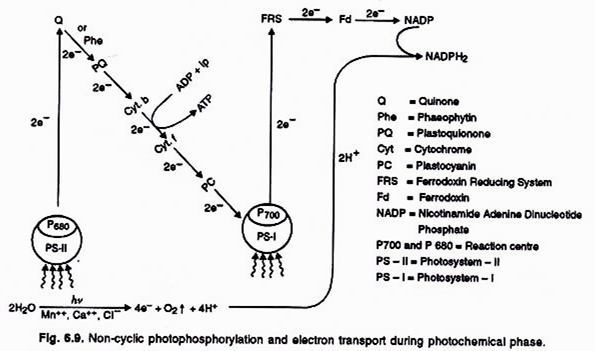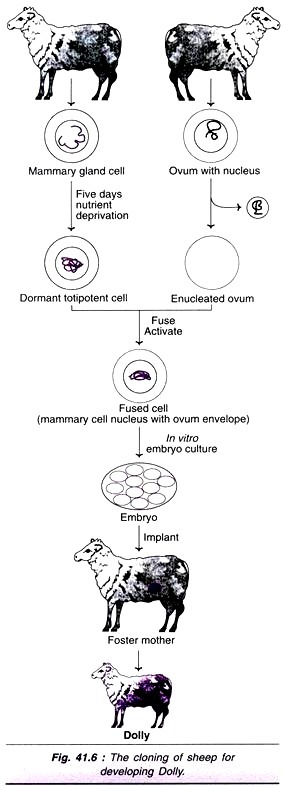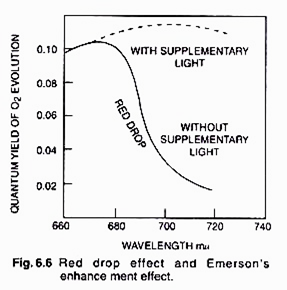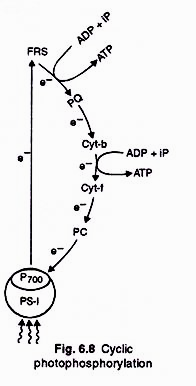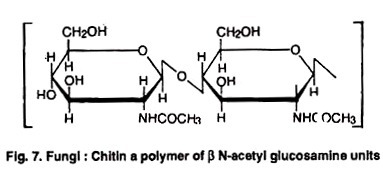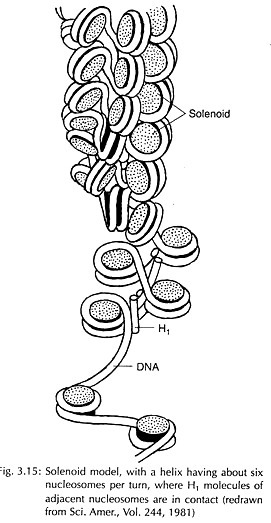The life history of Sacculina is extremely interesting. The actual mechanism of fertilisation is not known. Opinion varies regarding the process of fertilisation. According to Delage’s view all the batches of the eggs are fertilized by the sperms of the same individual except the first batch. So this kind of fertilisation is known as self fertilisation. But above all the probabilities, the fertilisation is internal.
A degenerated adult female lays eggs in bunches with the help of cementing glands which provides a cuticular covering. The two batches of the eggs are attached in the broad chamber through a minute hood like elevation called retinacula. These retinacula are internal elevations of the brood chamber. The young ones are hatched from the egg as a free-swimming Nauplius larva (Fig. 14.7).
Development:
(a) Nauplius larva is more or less triangular in shape. This larva is peculiar in having two fronto-lateral horns with gland cells. It has a median eye and three pairs of appendages for swimming. The second and third pair of appendages are devoid of any masticating organ. The anterior one pair of uninamous appendages are similar to the antennules.
The second and third pairs of appendages are biramous appendages which are present on each lateral side of the body. These two pairs of appendages are similar to the antennae and the mandibles respectively.
The mouth and alimentary canal are absent in Nauplius larva and it contains numerous germ cells or primitive ova. The body of this larva is not segmented and the posterior end of the body terminates into the caudal furca. In course of development the Nauplius larva transforms into a Cypris stage (Fig. 14.2).
(b) Cypris larva:
After 3 to 4 months the Nauplius larva is converted into a Cypris larva. The free swimming Cypris bears a bivalved shell. The anterior region consists of a pair of three segmented uniramous appendages or limbs, a single median eye, a pair of fronto-lateral gland, a mass of undifferentiated germ cells and the fat globules.
The posterior region of the body is provided with six pairs of biramous thoracic appendages which are responsible for swimming. The abdomen of Cypris stage is rudimentary and terminates into a pair of caudal rami.
The anterior uniramous appendages are called antennule and the terminal segment of the antennule is provided with backwardly directed filamentous process which acts as an organ of attachment. After 3 to 4 days of swimming, the Cypris larva attaches itself to the body of the crab by the help of its hook like antennule (Fig. 14.3).
(c) Kentrogen larva:
After free-swimming stage of 3-4 days, the Cypris larva fixes itself to the dorsal part of the young crab at the base of larval setae with the help of the hook like antennules. This transitional stage is known as Kentrogen stage. It then discards thoracic appendages, bivalved shells and muscles. The anterior part of the body is detached and is enclosed within a sac that remain in connection with the antennule that is fixed with the body of the host.
The old cuticle of this larva is replaced by a new one and encloses the whole body like a sac. The pointed end of the cuticle begins to bore the body of the host (crab). A chitinous rod is differentiated within the body known as dart. With the help of the dart and the pointed anterior end of the cuticle, the soft body enters into the body cavity of the host.
The content of the sac along with mass of undifferentiated cells, covered with ectodermal layer, pass into the body of the host through this dart. These cells are carried through blood stream into the thoracic cavity (Fig. 14.4).
(d) Sacculina interna:
When the kentrogen larva enters within the body of a host crab, the cells of the parasite divide rapidly giving to a stage called Sacculina interna. It then sends slender processes throughout the body of the crab to draw nourishment.
The internal sacculina takes its position within the connective tissue in between the intestine and the muscles of the ventral wall. The main body of the Sacculina interna, as it continues to grow degenerates the tissues of the host’s body wall (Fig. 14.5).
(e) Sacculina externa:
The main body of the parasite now pushes out as a swelling near the abdomen of the crab. This phase is called the Sacculina externa. The internal sacculina grows slowly and gives pressure to the ventral wall of the host abdomen and it comes out of the body cavity through a small aperture. This stage is known as Sacculina externa (Fig. 14.6).
